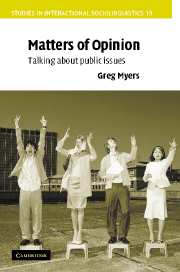Book contents
- Frontmatter
- Contents
- Acknowledgments
- Transcription conventions
- Focus-group data
- 1 Paradoxes of opinion
- 2 A tool kit for analysing group discussions
- 3 Forums for opinion: ‘What is it that's going on here?’
- 4 Institutions of opinion: voice of the people?
- 5 Topics in interaction: ‘Why that now?’
- 6 Agreeing and disagreeing: maintaining sociable argument
- 7 Representing speech: other voices, other places
- 8 Questioning expertise: Who says?
- 9 Radio phone-ins: mediated sociable argument
- 10 Vox pop television interviews: constructing the public
- 11 Opinions as talk
- References
- Index
10 - Vox pop television interviews: constructing the public
Published online by Cambridge University Press: 22 September 2009
- Frontmatter
- Contents
- Acknowledgments
- Transcription conventions
- Focus-group data
- 1 Paradoxes of opinion
- 2 A tool kit for analysing group discussions
- 3 Forums for opinion: ‘What is it that's going on here?’
- 4 Institutions of opinion: voice of the people?
- 5 Topics in interaction: ‘Why that now?’
- 6 Agreeing and disagreeing: maintaining sociable argument
- 7 Representing speech: other voices, other places
- 8 Questioning expertise: Who says?
- 9 Radio phone-ins: mediated sociable argument
- 10 Vox pop television interviews: constructing the public
- 11 Opinions as talk
- References
- Index
Summary
The phrase vox populi, ‘the voice of the people’, predates broadcasting; the OED gives an instance from 1550. But it is broadcasting that has given the phrase (in its shortened form) a specific meaning, as press or broadcast segments in which a series of usually unidentified people are asked to state an opinion on an issue briefly. The statements are then edited together so that the whole series, rather than any one speaker, is taken to represent the voice of the people.
Just as radio phone-ins would seem to be a drastically attenuated form of public argument, vox pop interviews on television might seem to be a drastically reduced visual representation of public opinion. Who is to say these people on a street in Washington can stand for all the people who make up ‘the public’? And who is to say that their offhand thirty-second responses to a question we do not hear can stand for ‘opinion’? It is not surprising that vox pops do not seem to be taken very seriously by broadcasters; they may be used at the end of a news report, or as a light introduction to what is seen as an abstract item, or in local news as a kind of filler. I will argue they are important, despite this apparent marginality, because they are key examples of the way broadcasting can categorize people, visually and verbally, and from these categories constitute public opinion.
- Type
- Chapter
- Information
- Matters of OpinionTalking About Public Issues, pp. 203 - 222Publisher: Cambridge University PressPrint publication year: 2004



